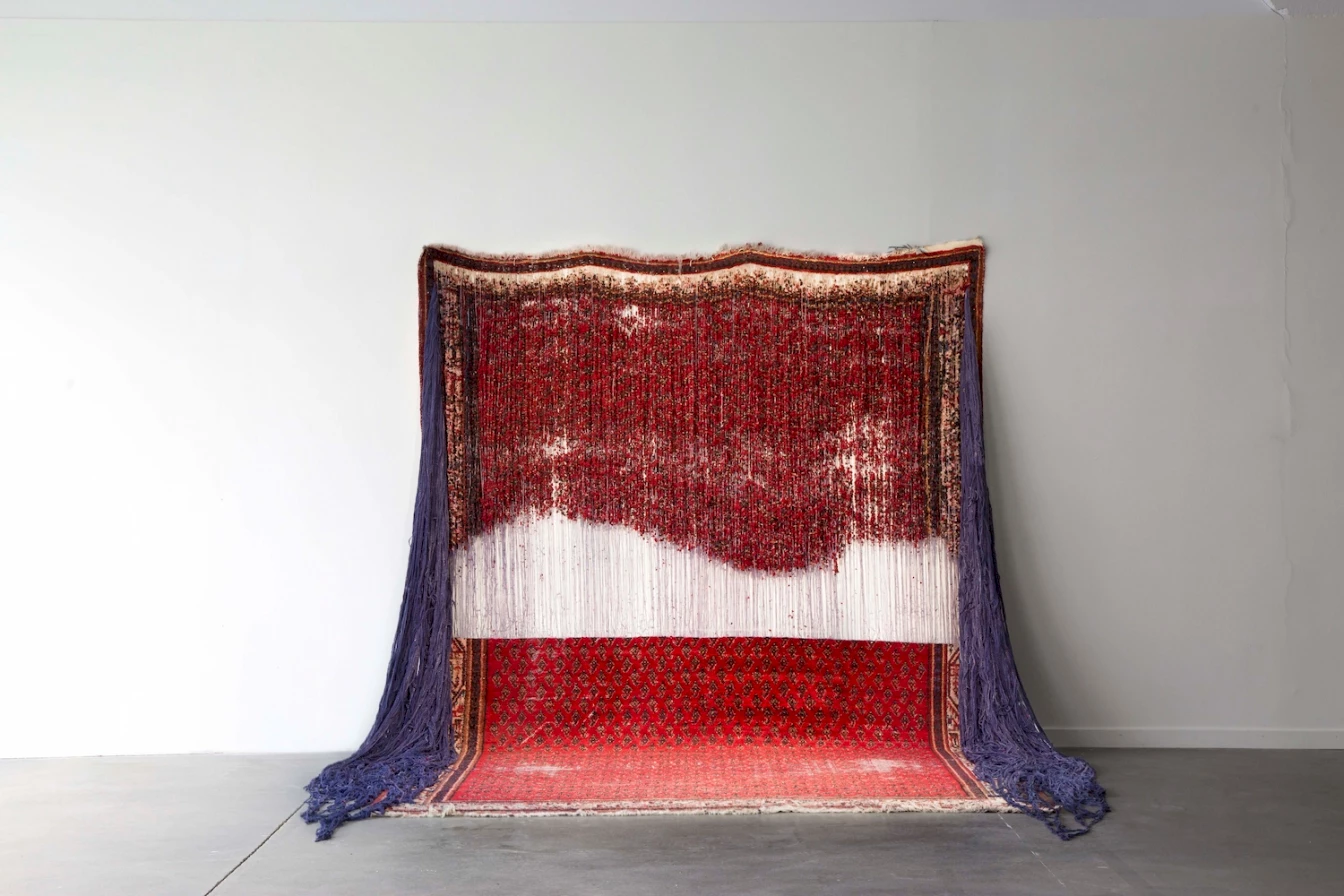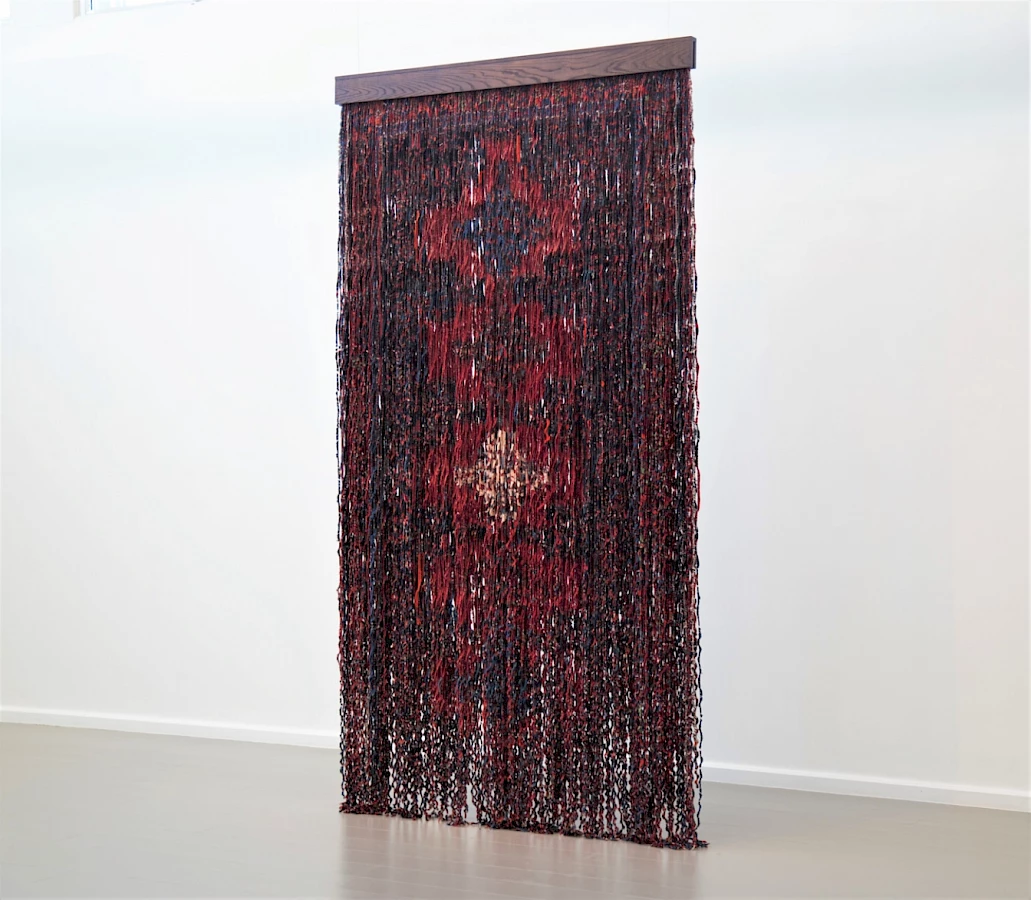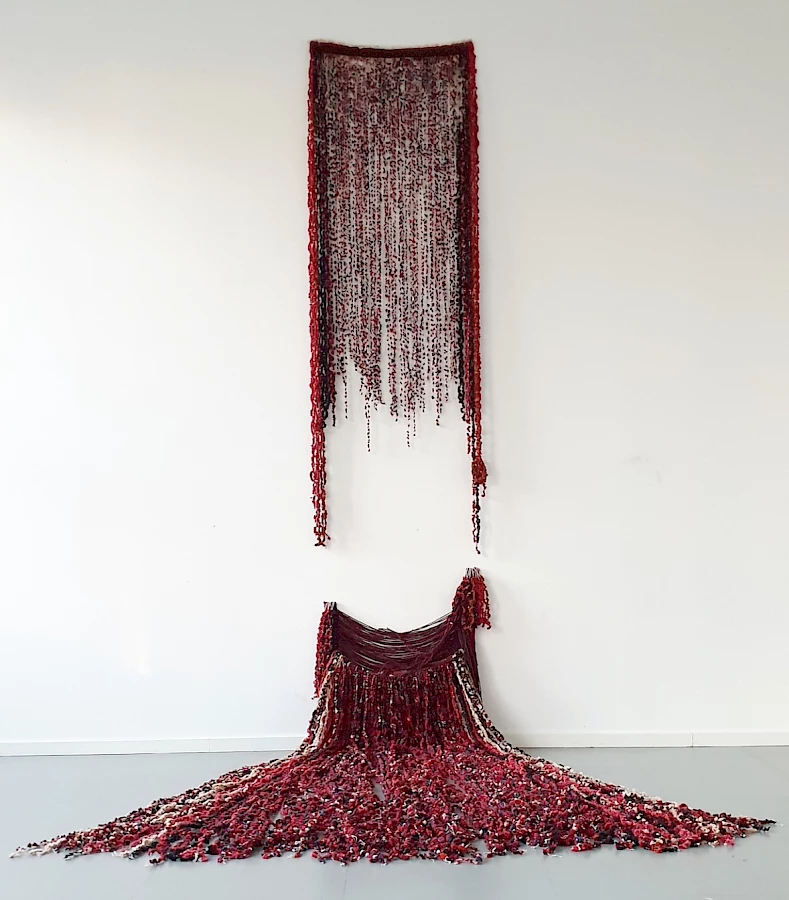
Ayedin Ronaghi, The Gathering series, 2019. Textile sculpture, deconstructed Persian rug by hand, 345 x 275 cm. Photo: Jasmin Daryani.

Ayedin Ronaghi, The Gathering series, 2021. Textile sculpture, deconstructed Persian rug by hand with wood frame, 420 x 155 cm. Photo: Jasmin Daryani.

Ayedin Ronaghi, The Gathering series, 2021. Textile sculpture, deconstructed Persian rug by hand, 420 x 83 cm. Photo: Jasmin Daryani.
Roberta Burchardt and Tatiana Pinto in conversation with Ayedin Ronaghi, 23 September 2021.
Roberta Burchardt/Tatiana Pinto: The way we see your work in this publication is bringing the possibility of undoing something. What is it that you are undoing?
Ayedin Ronaghi: I was five-six years old when I moved to Sweden, and the first few years I was busy growing up, learning the language, making friends and being a teenager and I was never really that interested in Iran. I remember my parents trying really hard to get my sister and me closer to the Iranian culture but we were really rejective and the Persian rug for some reason symbolizes those years for me. In The Gathering, I worked with some rugs that I inherited from my great grandmother, but for decades they just laid in the attic because I didn't want anything to do with them. And it was that rejection that I found interesting and I wanted to explore that further. But when I first started to experiment with the rugs, I realized that I was trying to completely change the rugs into something else, as if I was trying to erase every part that visually was Iranian. So, I started to wonder: “Haven’t you done this your entire childhood? Trying to distance yourself from your background”? And it was then that I also knew that I had found the right material for this project. But the Persian rug is not only a symbol of course. Traditionally we sit on the floor, on the rug and it’s where the family gathers and has meals.I guess my intentions with this process of undoing has been a way of reliving and processing the past and that 70 years of violence and conflict.
RB/TP: This history of violence that is 70 years long, that you talk about but have not lived through; it is lived by your parents and grandparents. That is something that you also had to confront, the silence you experience in the family. Is it so that by sitting with these rugs you can also reminisce and go back to this, these Eras?
AR: I would love to but unfortunately, I can only go back to my own feelings towards these eras while I was growing up and, of course, to that silence I have experienced. But I also wonder if past events and trauma can be passed down to generations, that is something that I want to look into more.
RB/TP: The rug is this place that holds the family together, holds this peace at the moment.
AR: Yeah, but it also holds many secrets.
RB/TP: But there's also a coming to terms with this, no? There's a meeting point between the modern western body, and this other body that is part of a family and a history. There´s trauma in this history, but there's also beauty, richness, and ancestry to come to terms with. There's a coming to terms with that because you step on both terrains, you revisit both terrains. And choose how Swedish or Iranian, you can be. And perhaps the work is exactly this binding, or this middle-zone. Even though it's the Iranian icon that we see.
It's interesting to dislocate this a little. We now locate your whole trajectory and The Gathering, the rugs as based in the Iranian territory, and in that struggle and in that violence, and your understanding of that violence due to silence or fragmentation. But there's also a western gaze in the lived experience of undoing that specific history, trauma, silence. The work is made within the structures of western contemporary art, or? Does the undoing become the method, the way of doing art?
AR: I would say that the undoing is just that, but you bring up an interesting point, a difficult one. Because sometimes I find it hard to separate those things from each other. I grew up here, I am living here, my entire family is living here and we have our history here, but at the same time, we also have another history, one that has a lot of baggage, one that is not visible, but still real. So how do you separate those two from each other? Is it even possible or are they now the same? I think in the end it comes down to access and where you position yourself, but it is a difficult subject and one that I have carried with me throughout this entire project.
RB/TP: The whole idea of understanding we in the world, through decolonization, is to understand that complicity, of power, and of our Global space in society. And that it's not “they over there” and “we over here”. That is one thing. Then it is also important to talk about ancestry and relationship to land, as a means of grappling descent, lineage, transgenerational trauma.
The views and opinions published here mirror the principles of academic freedom and do not necessarily reflect the views or positions of the L'Internationale confederation and its members.